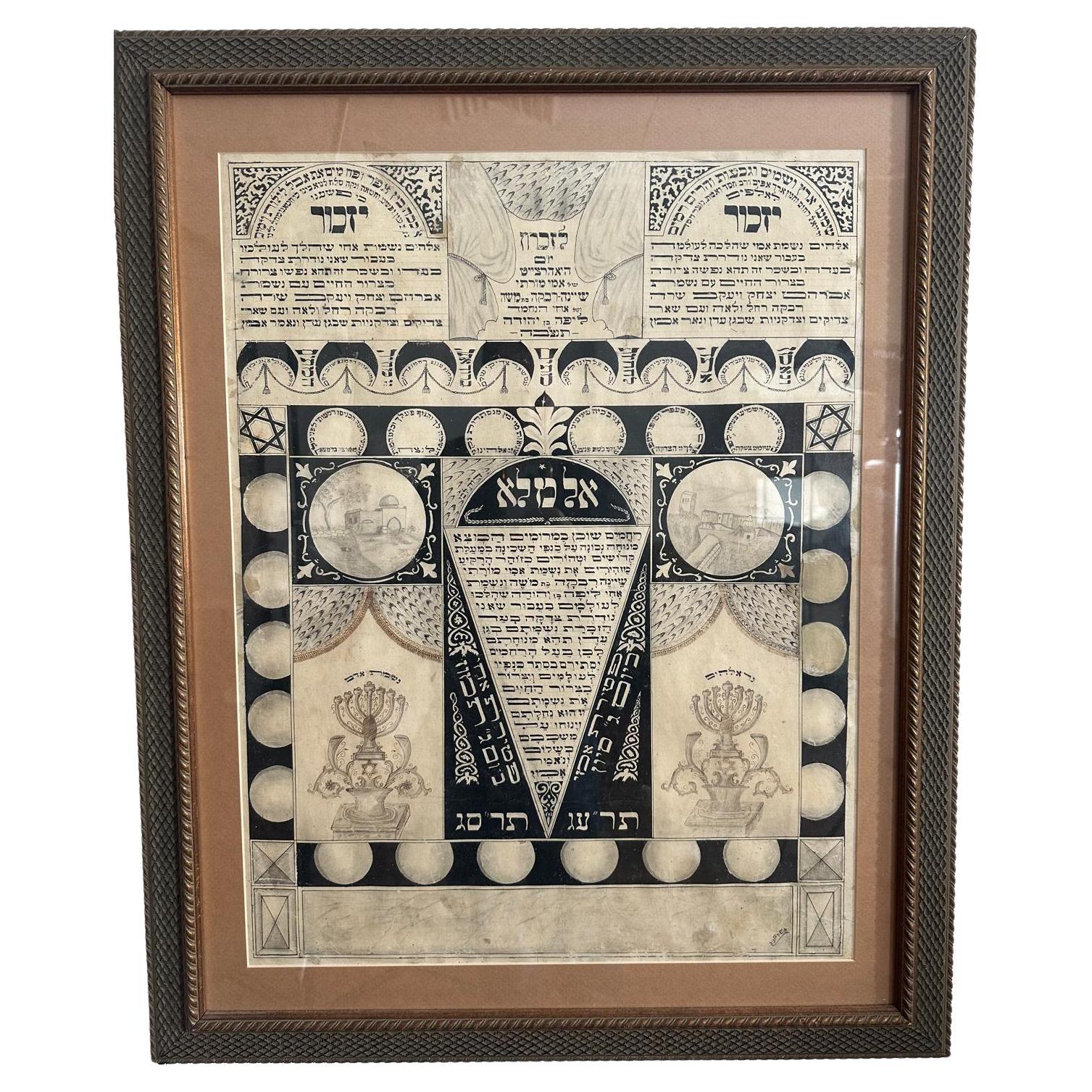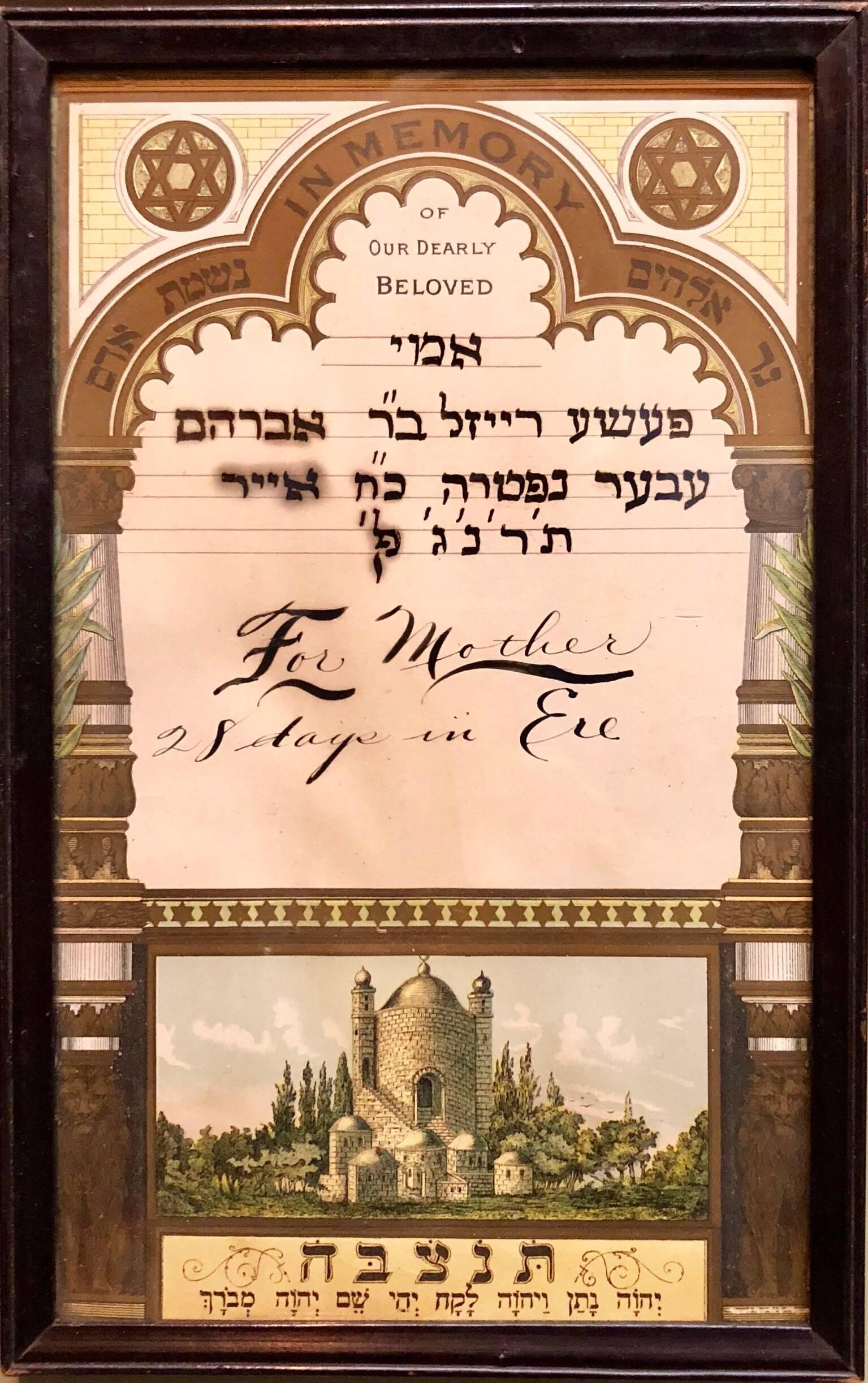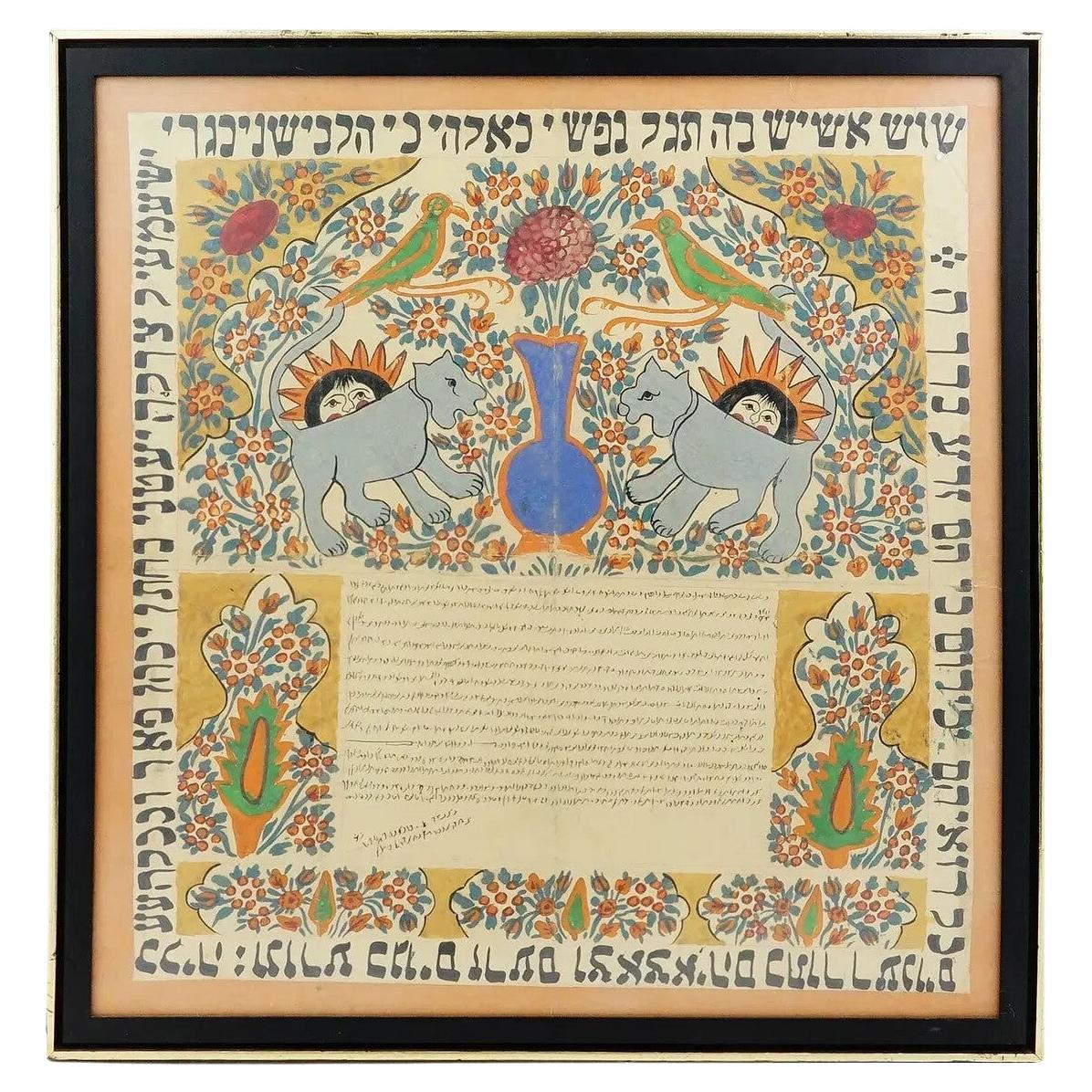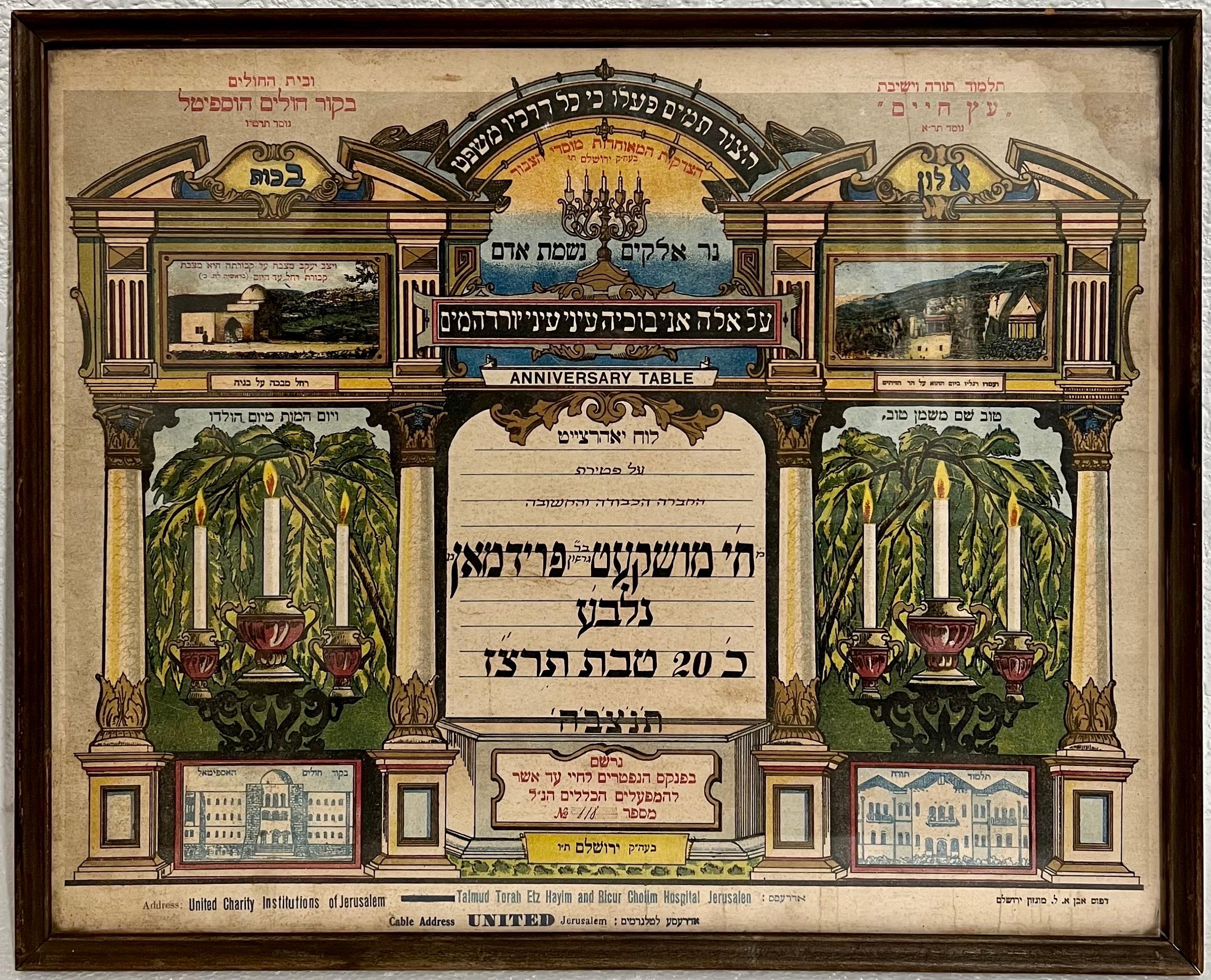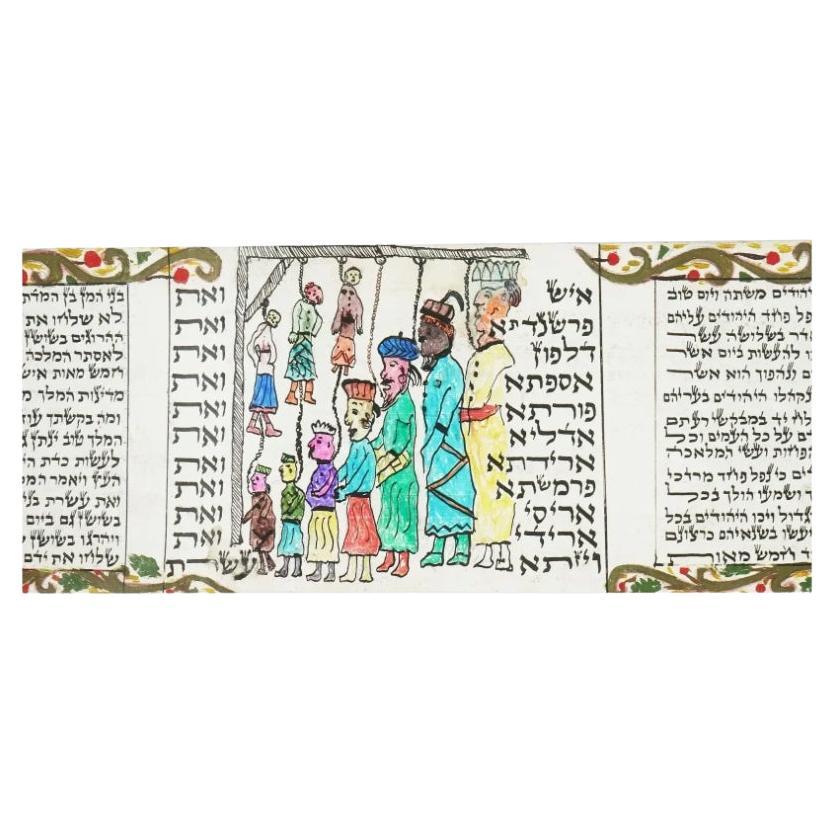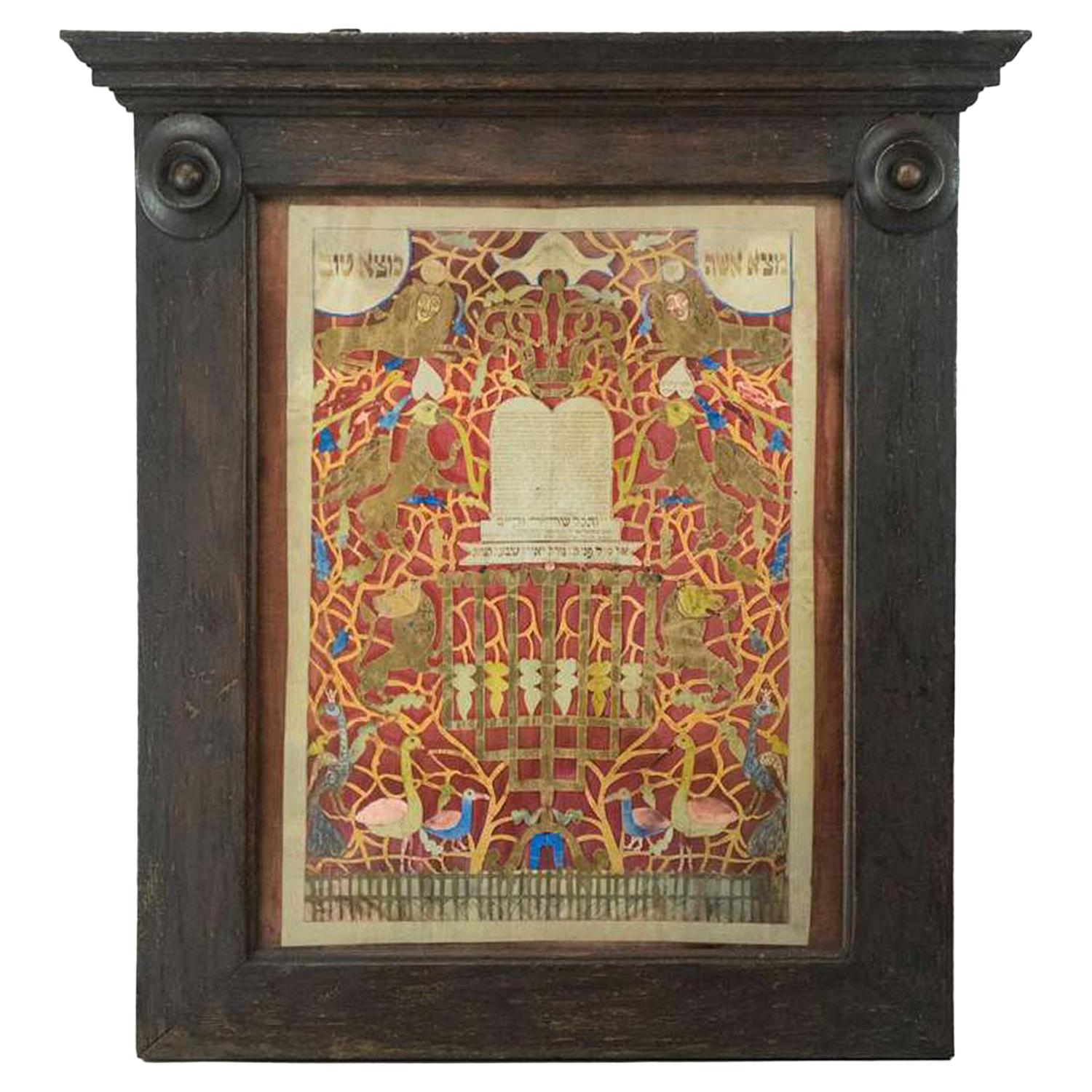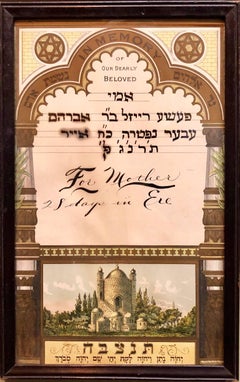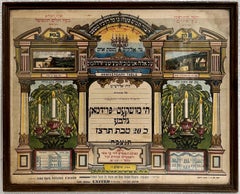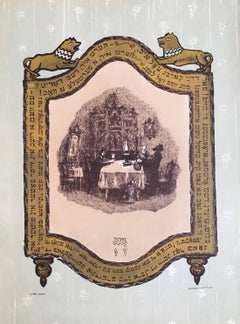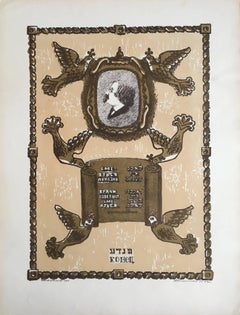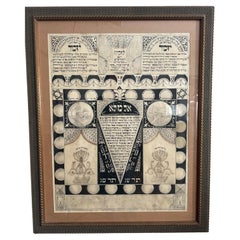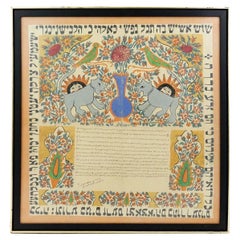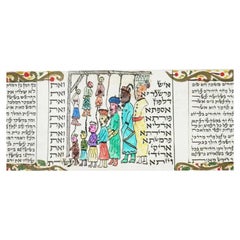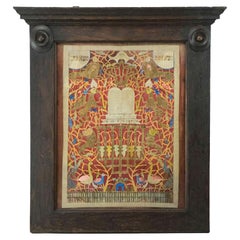Items Similar to Rare 1915 Early 20c Century Ketubah Hand Written Text NYC Hebrew Publishing co.
Want more images or videos?
Request additional images or videos from the seller
1 of 12
Leon Israel (Lola)Rare 1915 Early 20c Century Ketubah Hand Written Text NYC Hebrew Publishing co.1915
1915
$1,200
£911.92
€1,049.55
CA$1,717.26
A$1,886.78
CHF 973
MX$22,605.51
NOK 12,354.10
SEK 11,593.82
DKK 7,838.66
About the Item
Vintage Jewish marriage contract, Most likely printed in the USA or Germany. Used in Pittsburgh, Pennsylvania, hand dated 1921. A rare early American judaic piece. Printed in gold and blue
written out in a beautiful Hebrew calligraphy and English. Printed by Hebrew publishing company New York city. It records the marriage between Robert Amper and Lillian Ehrenpreis in Pittsburgh in 1921.
The Ketubah (pl. ketubot) is the standard marriage contract that Jewish law require a groom to provide for his bride on their wedding day. It is intended to protect the woman, primarily by establishing the man's financial obligations to her in case of divorce. Although many Jewish communities throughout the centuries have decorated their ketubot, Italian Jews during the 17th and 18th centuries stood out for cultivating the art of ketubah illumination. Italian ketubot commonly featured rich floral ornamentation and images from the Bible as well as from Greek and Roman mythology. They often depicted biblical personalities whose names were identical with those of the bride and groom, or they used images to identify their individual attributes (virtue, charity, etc.). The symbol of the spread out hands of the high priest denoted that the groom was of the priestly family (Kohen). Some have incorporated a coat of arms, an object such as an urn, or a floral or geometric design which often included micrographic designs (the creation of images with minute Hebrew letters).
- Creator:Leon Israel (Lola) (1887 - 1955)
- Creation Year:1915
- Dimensions:Height: 18 in (45.72 cm)Width: 25 in (63.5 cm)
- Medium:
- Movement & Style:Gothic
- Period:
- Condition:wear commensurate with age and use, minor tears, see photos.
- Gallery Location:Surfside, FL
- Reference Number:1stDibs: LU38214152482
About the Seller
4.9
Platinum Seller
Premium sellers with a 4.7+ rating and 24-hour response times
Established in 1995
1stDibs seller since 2014
1,818 sales on 1stDibs
Typical response time: 1 hour
- ShippingRetrieving quote...Shipping from: Surfside, FL
- Return Policy
Authenticity Guarantee
In the unlikely event there’s an issue with an item’s authenticity, contact us within 1 year for a full refund. DetailsMoney-Back Guarantee
If your item is not as described, is damaged in transit, or does not arrive, contact us within 7 days for a full refund. Details24-Hour Cancellation
You have a 24-hour grace period in which to reconsider your purchase, with no questions asked.Vetted Professional Sellers
Our world-class sellers must adhere to strict standards for service and quality, maintaining the integrity of our listings.Price-Match Guarantee
If you find that a seller listed the same item for a lower price elsewhere, we’ll match it.Trusted Global Delivery
Our best-in-class carrier network provides specialized shipping options worldwide, including custom delivery.More From This Seller
View AllRare Judaica 1893 Jewish Yizkor Memorial Plaque Hebrew English Chromolithograph
Located in Surfside, FL
A rare Judaic memorial piece for mother.
Category
Late 19th Century Aesthetic Movement More Prints
Materials
Lithograph
Rare Palestine Antique Hebrew Judaica Yahrzeit Synagogue Sign Memorial Plaque
Located in Surfside, FL
Circa 1890-1920. This Neoclassical, Judaic, Egyptian revival, Orientalist Mizrach sign, was produced in British Mandate Palestine by the chromolithograph process at the beginning of the 20th century. It pictures vignettes of holy places. with a hand written memorial. It was for the Tzedakah charity fund for the century-old institutions in Jerusalem: The great "Torah Center Etz Chaim"; a Free Kitchen for poor children and orphans; the famous Bikur Cholim Hospital with its dispensaries and clinics and the only Home for Incurable Invalids in Eretz Israel. They also worked with Arthur Szyk and Alfred Salzmann.. The A.L. Monsohn Lithographic Press (Monzon Press, Monson Press, דפוס אבן א"ל מאנזאהן, דפוס מונזון) was established in Jerusalem in 1892 by Abraham-Leib (or Avrom-Leyb) Monsohn II (Jerusalem, c.1871-1930) and his brother Moshe-Mordechai (Meyshe-Mordkhe). Sponsored by members of the Hamburger family, the brothers had been sent to Frankfurt, Germany in 1890 to study lithography. Upon returning to Jerusalem in 1892 with a hand press, they established the A.L. Monsohn Lithographic Press in the Old City of Jerusalem. According to the Information Center for Israeli Art A.L. Monsohn "created complex decorations for documents and oriental calendars that combined the tradition of Jewish art with modern printing techniques such as photographic lithography, raised printing and gilding."
The founders of the Monsohn press produced Jewish-themed color postcards, greeting cards, Jewish National Fund stamps, and maps documenting the evolution of the Jewish settlement in Eretz Israel in the nineteenth-twentieth centuries; religious material such as decorative plaques for synagogues, portraits of Old Yishuv rabbis such as Shmuel Salant, Mizrah posters indicating the direction of prayer for synagogues, memorial posters, and posters for Sukkot booths; color frontispieces for books such as Pentateuch volumes and the early song collections of Abraham Zvi Idelsohn (e.g., Shire Zion, Jerusalem 1908); artistic wedding invitations; and labels, packaging and advertisements for the pioneering entrepreneurs of Eretz Israel. The texts appearing in the Monsohn products were in several languages: Hebrew, Arabic, Yiddish, English, German (e.g., a c1920 trilingual Hebrew-English-Arabic "Malaria Danger" broadside warning the public of mosquitoes spreading malaria). Many of the brilliantly colored postcards and maps can be seen online as can the artistic invitations to his children's weddings which Monsohn published in the Jerusalem Hebrew press.
For years, the Monsohn (later, Monson/Monzon) Press was considered the best and most innovative in the country—pioneering in such techniques as gold-embossing and offset printing, among others. Early items for tourists included collections of Flowers of the Holy Land (c. 1910–1918)—pressed local flowers accompanied by scenes from the Eretz Israel countryside and relevant verses from the Bible, edited by Jsac Chagise (or Itzhak Haggis), an immigrant from Vitebsk, and bound in carved olive wood boards. Shortly after World War I Monsohn (now spelled מונזון) used zincography to produce the prints included in the Hebrew Gannenu educational booklets for young children illustrated by Ze'ev Raban of the Bezalel Academy of Art and Design and printed in Jerusalem by Hayim Refael Hakohen (vol. 1, 1919; vols. 2–3, 1920). In 1934 Monsohn moved into the new, western part of Jerusalem, in a shop with four presses and 30 workers, including Abraham-Leib's sons, David, Yosef, Moshe and Shimon, and his daughter Raytse's husband, Abraham Barmacz. The concern did business with all sectors of the city's population, including Arabs, for whom they printed in Arabic. Among their clients were members of the Ginio, Havilio, and Elite families, and Shemen, Dubek, and other renowned national brands, manufacturing products such as wine, candies, oil, and cigarettes. They also printed movie and travel posters, and government posters, postcards and documents, hotel luggage labels...
Category
Early 20th Century Aesthetic Movement More Art
Materials
Lithograph
Vintage Russian Shtetl Scene, Judaica Lithograph
By Anatoli Lvovich Kaplan
Located in Surfside, FL
Pencil signed and dated, colored Judaica Lithograph.
Anatoli Lwowitch Kaplan was a Russian painter, sculptor and printmaker, whose works often reflect his Jewish origins.
his father was a butcher in Rahachow which was at that time within the Jewish Pale of Settlement in Russia. His background was therefore not dissimilar to that of Marc Chagall, born a generation earlier in 1887, and although their lives were very different, their art has much in common. The shtetl figures in many of Kaplan's paintings - autobiographical references are very clear in The Butcher's Shop (1972) and Tailor's Shops (1975) and in the many illustrations which he was to create to the works of Sholem Aleichem...
Category
Mid-20th Century Modern More Prints
Materials
Lithograph
Vintage Russian Shtetl, Scene Judaica Lithograph
By Anatoli Lvovich Kaplan
Located in Surfside, FL
Pencil signed and dated, colored Judaica Lithograph.
Anatoli Lwowitch Kaplan was a Russian painter, sculptor and printmaker, whose works often refl...
Category
Mid-20th Century Modern More Prints
Materials
Lithograph
Rare 1922 German Jewish Judaica Zion Woodcut Woodblock Print Hermann Fechenbach
By Hermann Israel Fechenbach
Located in Surfside, FL
Title: Zion
Subject: Various biblical images depicting Creation and prayer
1922
Medium: woodcut
Frame: 14" x 18"
Image: 12.5" x 16.75"
Provenance: owned and signed verso by Peter Keil.
Central panel shows the Jewish star over a crown, with inscription in Hebrew: "When God comforts Zion, He will comfort all its ruins and make its deserts look like Eden," and "You have sanctified the seventh day, the goal of creation of Heaven and Earth." This is flanked by a Palestinian farmer pioneer on the left and a Jew praying on the right. The lower tier shows six vignettes of the days of creation from Genesis.
Hermann Fechenbach was born in 1897 in Württemberg, Germany. He grew up in Bad Mergentheim where his parents had an inn, which served as a meeting place for the local Jewish community.
He left school early and through family connections with clothing retailers received training in window dressing. His skill with brush writing was quickly recognised by a big firm in Dortmund where he was responsible for the displays in 10 large windows. He received his conscription papers in 1916 and recalls “being as patriotic as any other fool”. In August 1917 he was involved in a grenade attack in which he was the sole survivor. With serious injuries to both legs he struggled to safety and was eventually transported to a front line “slaughterhouse” where the first of a series of amputations was performed which led to the loss of his left leg.
As a result of his injuries his father dropped his opposition to him becoming an artist. His formal art education started in 1918 with training at a Stuttgart handcraft school for invalids. He attended the Academies in Stuttgart and Munich to learn painting and restoration for 3 years. He was influenced at this time by Max Liebermann. He has been compared to Kathe Kollwitz and was a contemporary of Jakob Steinhardt and hermann Struck. In 1923 he went to Florence for a year. While in Florence he started to produce a series of miniature wood engravings to illustrate the stories of Genesis. This was followed by periods in Pisa, Venice, Vienna and Amsterdam. In 1924 he returned to Stuttgart to paint in the contemporary style “Die Neue Sachlichkeit”. (The New Objectivity was a movement in German art that arose during the 1920s Weimar republic as a reaction against expressionism. The term was coined by Gustav Friedrich Hartlaub, the director of the Kunsthalle in Mannheim, who used it as the title of an art exhibition staged in 1925 to showcase artists who were working in a post-expressionist spirit. These artists—who included Max Beckmann, Otto Dix, George Grosz, Christian Schad, Rudolf Schlichter and Jeanne Mammen) Every spring and autumn he exhibited at the “Kunstgebit” which served as the showcase for all serious artists of the period.
His professional status “Kunstmaler und Grafiker” was recognised by Berlin in 1926. Practically all his work from this period was sold following exhibition.
In 1926 he collaborated with an architect friend to build a bungalow in Hohenheim, a non-Jewish area and a suburb of Stuttgart. Hermann alternately lived in his country bungalow and his town studio, producing portraits for sale or barter and wood engravings for his own pleasure.
In 1930 he married a non-Jewish professional photographer – Greta Batze. They had a studio in Stuttgart, which was used to teach art to a group of 12 students.
In 1933 the Nazi influence removed his name from the official state register together with the right to exhibit. By spending most of his time in his bungalow out of the Jewish quarter the Fechenbachs escaped being registered by the Nazis for some years. They were ostracised and abused by their non-Jewish neighbours. Hermann made weekly visits to friends in town to teach them the practical skills they would need assuming they were to escape from Germany. His energies were directed towards protection and survival.
Ultimately the Nazi persecution forced the Fechenbachs to flee their homeland. They moved to Palestine for 3 months in 1938, but found the political and physical environment unsustainable.
Greta arrived in England penniless in January 1939 to work as a domestic servant and to find a guarantor for her husband. Hermann arrived in May 1939. They moved to Blackheath a few months later. Hermann resumed his painting and engraving as a means of earning a living. He raised enough money to get his parents out of Germany to join his brothers in Argentina but was unable to save his twin sister Rosa who died in a Nazi concentration camp. In 1940 Hermann was interned in Bury as a suspect alien. He protested about his treatment by starting a hunger strike. Because of his persistence he was moved to a prison in Liverpool. From Liverpool he was moved to the Hutchinson Camp in the Isle of Man with fellow artist Kurt Schwitters. Arrangements were made for Greta to be accommodated near by. While interned he commenced work on “Refugee Impressions”, a series of linocut prints (no wood was available).
In 1941 when released from internment the Fechenbachs came under the sponsorship of Dr. Bela Horovitz, the Austrian art publisher who in turn made an introduction to Professor Tancred Borenius.
They were offered lodgings with a family in Oxford. Hermann had his first public exhibition for many years in a small gallery in Oxford in 1942. A second exhibition of oils, pencil drawings, coloured linocut and woodblock prints held later in the year was opened by the mayor of Oxford and critically acclaimed.
In 1944 the first London exhibition took place at the Anglo-Palestinian club in Piccadilly. There were two exhibitions at the Ben Uri Art gallery during this period.
In 1948 a second exhibition at the Anglo Palestinian club was inaugurated by a member of the Rothschild family and several members of Parliament. This was a great success.
In 1944 the Fechenbachs moved to a top floor studio flat in Colet Gardens. Open exhibitions were held each Spring at the Embankment from 1946 to 1951. Movietone News produced a short feature on the artist, which was shown in cinemas in England and Germany.
In 1969 he published the Genesis story in a hard back volume containing 137 prints. He started to research the fate of the entire Jewish community of Bad Mergentheim during the period of the second world war, liaising with historian Dr. Paul Sauer and Professor Max Miller, historian and theologian. In 1972 Kohlhammer published his partly autobiographical book “The last Jews of Mergentheim”. He exhibited at the Anglo-Palestinian Club & the Ben Uri Gallery in the 1940s. His works only came to prominence during the last year of his life when he exhibited at Blond Fine Art.
Peter Keil part of the Junge Wilde. In 1978, the Junge Wilde painting style arose in the German-speaking world in opposition to established avant garde, minimal art and conceptual art. It was linked to the similar Transavanguardia movement in Italy, USA (neo-expressionism) and France (Figuration Libre). They were also known as the Neue Wilde. Artists included; Austria: Siegfried Anzinger, Erwin Bohatsch, Herbert Brandl, Gunter Damisch, Hubert Scheibl, Hubert Schmalix...
Category
1980s Impressionist Figurative Prints
Materials
Woodcut
Vintage Russian Ukrainian Shtetl Scene Judaica Lithograph Jewish Portrait
By Anatoli Lvovich Kaplan
Located in Surfside, FL
Pencil signed and dated, Judaica Lithograph.
Anatoli Lwowitch Kaplan was a Russian painter, sculptor and printmaker, whose works often reflect his Jewish origins.
His father was a b...
Category
Mid-20th Century Modern More Prints
Materials
Lithograph
You May Also Like
Hungarian Yizkor and El Male Rachamim Memorial Prayer Scroll, 1903
Located in New York, NY
This finely crafted ink-on-paper manuscript from 1903 features the Yizkor and El Male Rachamim prayers, traditional Jewish memorial prayers recited for the souls of the deceased. The...
Category
Early 20th Century Hungarian Religious Items
Materials
Paper
1840S PERSIA Isfahan JUDAICA ILLUMINATED MARRIAGE CONTRACT Ketubah
Located in Long Island City, NY
A Jewish Ketubah, or marriage contract. Isfahan, Persia, Qajar Empire, ca. 1840s. Hand-written document with colored illustrations, including lion and sun, the Imperial symbols of po...
Category
Antique 19th Century Unknown Paintings
Materials
Paint
Antique Judaica Hand Illuminated Megillah Scroll of Esther Manuscript
Located in Long Island City, NY
An antique Megillah The Book of Esther, hand written on parchment by an expert Sephardi scribe and richly decorated with hand painted illustrations. The text panels are surrounded by...
Category
Antique 19th Century Unknown Drawings
Materials
Parchment Paper
$2,925 Sale Price
35% Off
Early 20th Century Eastern European Paper Cut Ketubah, Jewish Marriage Contract
Located in New York, NY
An Eastern European Kethubah Strikingly Decorated in Papercut Form, and with the Central Traditional Hebrew Text of a Most Uncommon Petite Appearance.
Uni...
Category
Antique Early 1900s European Religious Items
Materials
Paper
$15,600 Sale Price
20% Off
"Song of Songs Illustration" Old Testament, Signed in Hebrew, Pencil & Ink
Located in Detroit, MI
"Song of Songs Illustration" renders an important bibilical story that is celebrated during Jewish Passover. Song of Solomon, also called Canticle of Canticles, or Song of Songs, an ...
Category
Mid-20th Century Other Art Style Figurative Drawings and Watercolors
Materials
Ink, Pen
Brachot for the Baal Tokeah on Rosh Hashanah
Located in New York, NY
An evocative and finely preserved antique printed sheet containing the Brachot (blessings) recited by the Ba’al Tokeah, the shofar blower, on Rosh Hashanah. This piece was an essenti...
Category
Early 20th Century Religious Items
Materials
Parchment Paper
